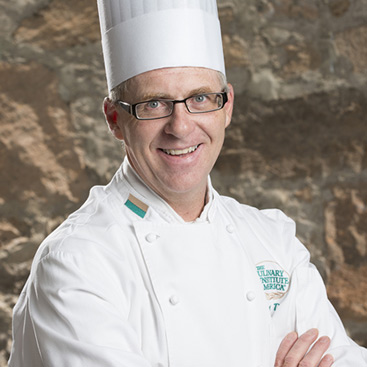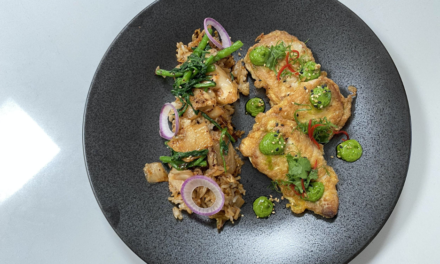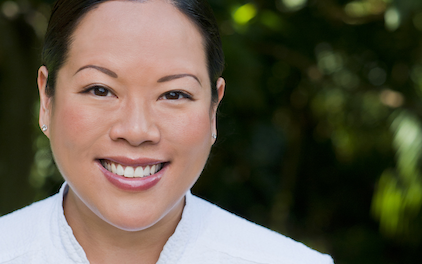Originally published in the Hawaii Food & Wine Festival 2013 program and
updated in April 2021 during a follow-up interview with Stephen Durfee.

Stephen Durfee is a Professor of Pastry and Baking Arts, Culinary Institute of America, St. Helena, Calif. Photo: courtesy of Stephen Durfee
You can’t get any higher, it may seem, than being the executive pastry chef at the famed French Laundry in Yountville, Calif. Unless you’re Stephen Durfee. Then you’d have to receive the James Beard Award for “Pastry Chef of the Year” and be named one of the “Ten Best Pastry Chefs in America.” And if that weren’t enough, he earned a bronze medal for the 2010 World Chocolate Masters National Selection and was selected to join Pastry Team USA to compete in the prestigious Coupe du Monde de la Patisserie in Lyon, France. And though he can make and plate a mean Callison D’Aix Charentais Melon Parfait Glace and Quinine Sorbet, he tends to crave peanut butter and jelly sandwiches.
CET: How did you get into pastry competitions?
SD: I got into competing after watching the U.S. pastry team in the World Pastry Championships in Las Vegas. It was cool to watch and I loved the intensity and action. I missed some of that when I left working the line’ for teaching. I got onto a three-person team in 2005 and we took fourth in my first-ever try. From there, we went back in 2007 and finished third but our program was s0 much better after all we had learned from the first go ’round.
CET: How has competing impacted your teaching at the Culinary Institute of America?
SD: I switched to individual contests so that I would force myself to learn how to make showpieces. Prior to that, I had only made desserts. I chose chocolate as my medium — it seemed the most logical to learn — and I was able to add a chocolate sculpture lesson to my class at CIA. That way, I could teach some basic skills to my students as I perfected them myself.
CET: What was it like competing in the Coupe du Monde de la Patisserie?
SD: I would have loved to bring home a medal, but I can’t say that I had expected to. We did finish fourth and missed third by only 30-some points. Not having participated in this caliber of contest before, it’s hard to imagine what the judges will be looking for and what new techniques your competitors will unveil. In the end, I was proud of what we did. Our food was great, and I think we learned that our concept for the showpieces did not coincide with the judges’ narrow expectations. We were ahead of our time.
CET: How does competing compare to restaurant service?
SD: I think that competing is very much like restaurant service in that you have to organize yourself in a very specific way to minimize opportunity for mistakes. Of course, the artistic side is quite different, but still you have to set goals, write prep lists, rely on teammates, learn from observation, develop new techniques that you want to show off. And I like being the center of attention. Do you remember a children’s book, Mike Mulligan and His Steam Shovel? That’s me.
Try Stephen Durfee’s Espresso Granite

CET: So what’s your all-time favorite thing to eat?
SD: I would have to say a peanut butter and jelly sandwich. I say this because I eat this almost every day as a snack. At CIA, we have a peanut butter grinder. There’s nothing like warm peanut butter with coarse salt. The jelly I’m less particular about.
CET: Got a pet peeve?
SD: A dirty apron.
CET:Do you have any big plans while you’re in town?
SD: So this is just a coincidence, but I recently started learning to play the ukulele. It was something relaxing to do, to unwind while I was prepping for the CDM. I went to an ukulele festival a few months ago and met a gentleman who is a third-generation ukulele builder from Honolulu. I hope to go see his place and maybe get to play some nice instruments while I’m there. And maybe pick up some new techniques.
With your busy schedule, are you still able to play the ukulele occasionally?
I absolutely do find time to play my ukulele, and my collection of instruments has grown a bit over the years. Currently, I have six ukes in different sizes and string set-ups. The original, a Kamaka Tenor, is still my favorite for playability and tone. And its the prettiest. (I’ve actually added a mandolin lately, as well — but don’t tell anybody!). I play a few times each week, some Hawaiian, but mostly contemporary music. My son is a guitar player so we do some duets and I also play music for a church service each weekend.
HASHI: It’s been over 8 years since our last documented interview (not 8 years since we’ve seen you!) – what have you been up to?
Well, in some ways, not much has changed. I just celebrated my 20-year anniversary as a pastry chef instructor at the CIA, so I’m still in the classroom every day, teaching the next generation of young cooks. On the other hand, my areas of interest have evolved. I used to be focused on restaurant-style “plated desserts”; where nowadays, I enjoy making “petite gateau,” pretty little cakes that you might find in a pastry shop case. Where I used to be crazy about chocolate bonbons, now I’m more into grinding cocoa beans to make my own chocolate. Oh, and I was promoted a few years ago. Now my title is “Professor of Baking and Pastry Arts!”
2020 was a tough year for the food and beverage industry, how did you spend your time? How did you have to pivot?
2020 was indeed a difficult year; although in retrospect, I have so much to be grateful for. While many friends lost their job, or even their whole business, we were able to adapt and continue to deliver our programs, through a combination of in-class and online course work. On a personal level, I aligned myself with the Fine Cacao and Chocolate Institute, and helped create recipes and content for a series of interview/discussions with cocoa farmers and chocolate makers. And I filmed a lot of cooking classes from my home kitchen!
What are you most looking forward to in 2021?
Hugs. Also, I’m really, really looking forward to actually seeing my students’ faces. I’ve spent a year teaching behind a mask and a plastic face shield…
What do you miss most about coming to Hawaii for HFWF?
I really miss seeing friends that I only saw at HFWF, which includes both chefs and also some guests that I met over the years. I miss the sweet, golden pineapples —the ones we get in California are not the same. And of course, I miss the beach!



